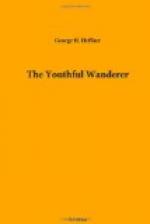The sun set soon after we had passed Orbetello, and the moon rose about the same time. We had still two hours to Civita Vecchia and four hours to Rome, but I shall never forget the happiness and emotional excitement that prevailed among our passengers, as we were approaching the city of the Caesars and of the Popes, on that pleasant moonlight evening. The light of the full moon cast a charm about every scene, and as we watched the appearance of tropical species of plants and trees under the subdued and enchanted light of the moon and stars, we felt that we were about to enter the celestial city under eminently fascinating circumstances. At 10:00 o’clock we were intently looking from the windows, each for the first glimpse of Rome. Will we reach the Tiber soon? As our train leaped upon the bridge and my French companion first saw the glassy surface of the historic stream, he, half distracted by solemnity of the occasion, exclaimed with a forced but feeble effort, “THE TIBER, the Tiber!” None was his own, and the enraptured Professor, sinking from the effects of an ecstatic swoon, grasped hold of me and with labored enunciation spoke in a low voice, saying, “I feel in-ex-pres-si-ble e-mo-sions!”
At 10:20 we entered the shed of the great Railway Station. It was my good fortune to meet a German porter who conducted me and my new companion to an excellent hotel (Albergo Torino E Trattoria duetto da Abrate—Via Principe Amedo in prossimita alla Stazione) where we took rooms together.
One sees a thousand strange and curious things at Rome that my limited space will preclude me from describing or mentioning, even. The gable-end of the Stazione (Station) has in base relief a representation of the traditional she-wolf nursing the twin brothers, Romulus and Remus, the founders of Rome.
Emblems unique and obscure in design, may be seen in almost every street. I saw in one place the hands of a clock dial in the form of snakes.
I did more justice to my eyes than to my feet, during my first day in Rome. The Column of Marcus Aurelius, the Post-Office, Castello S. Angelo, St. Peter, the Vatican, the Colosseum (Amfiteatro Flavia, or Coliseo) and the fountains, arches and ruins of ancient heathen temples that I passed on my way, gave me a pretty good practical idea of the Rome that I had read about in the books. Only the approaching darkness and the dread of walking alone through the suburbs of Rome under cover of night, could induce me on the evening of the first day to tear myself away from the crumbling heaps of stones which constitute the ruins of ancient Rome, so charming and grand to behold.
It required about three days of close study before I could readily identify on my map of ancient Rome, the temples of Vespasian, of Saturn, of Castor and Pollux, of Julius Caesar, of Faustina, and of Venus and Roma; the triumphal arches of Titus, of Severus and of Constantine; the Meta Sudarite, and the Column of Phocas, in the Roman Forum; also the Column of Trajan and other objects in the Forum of Trajan, and numerous other ruins of ancient Rome, including the aqueducts, baths, and the little round Temple of Vesta (?) on the left bank of the Tiber.




